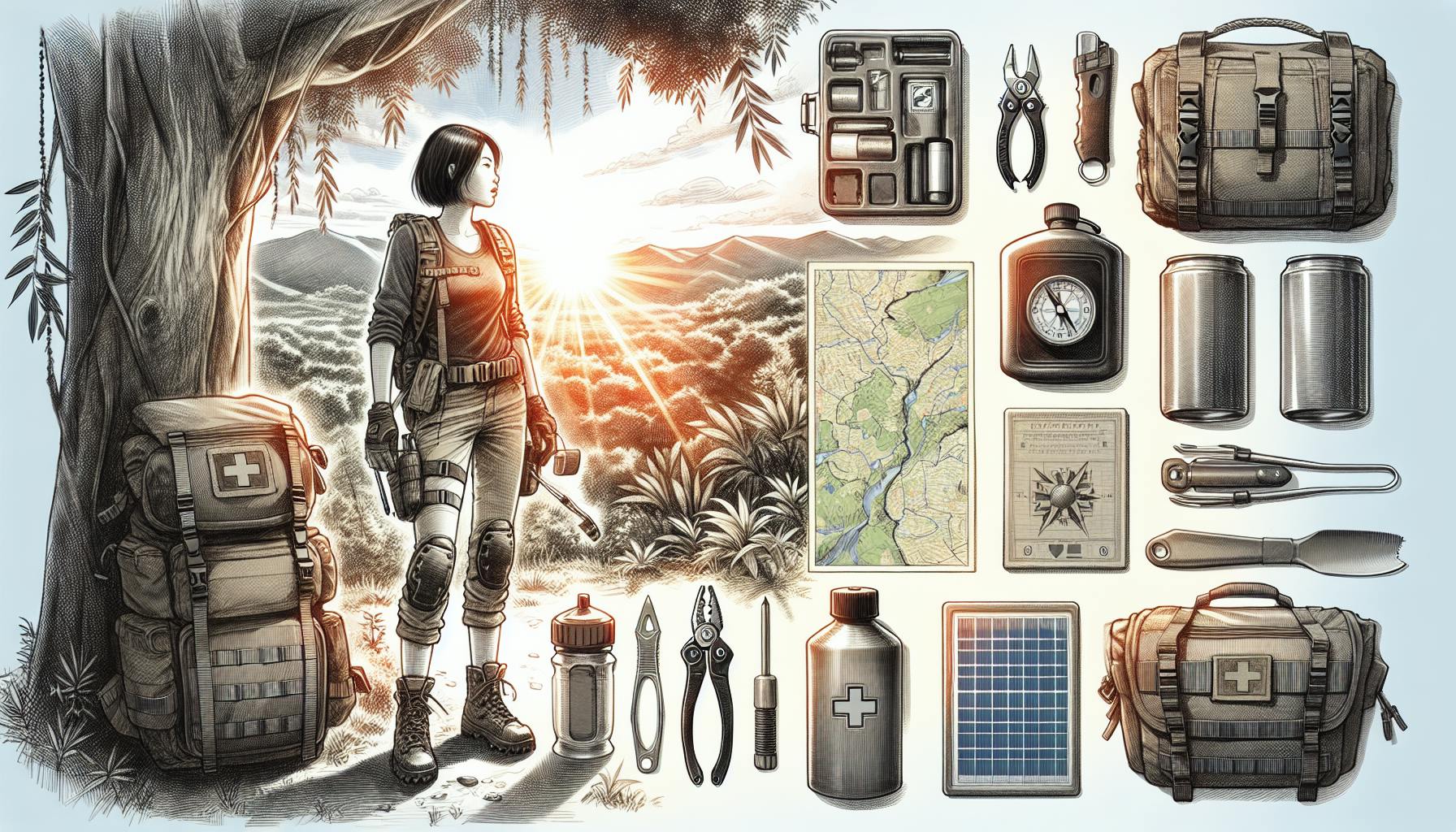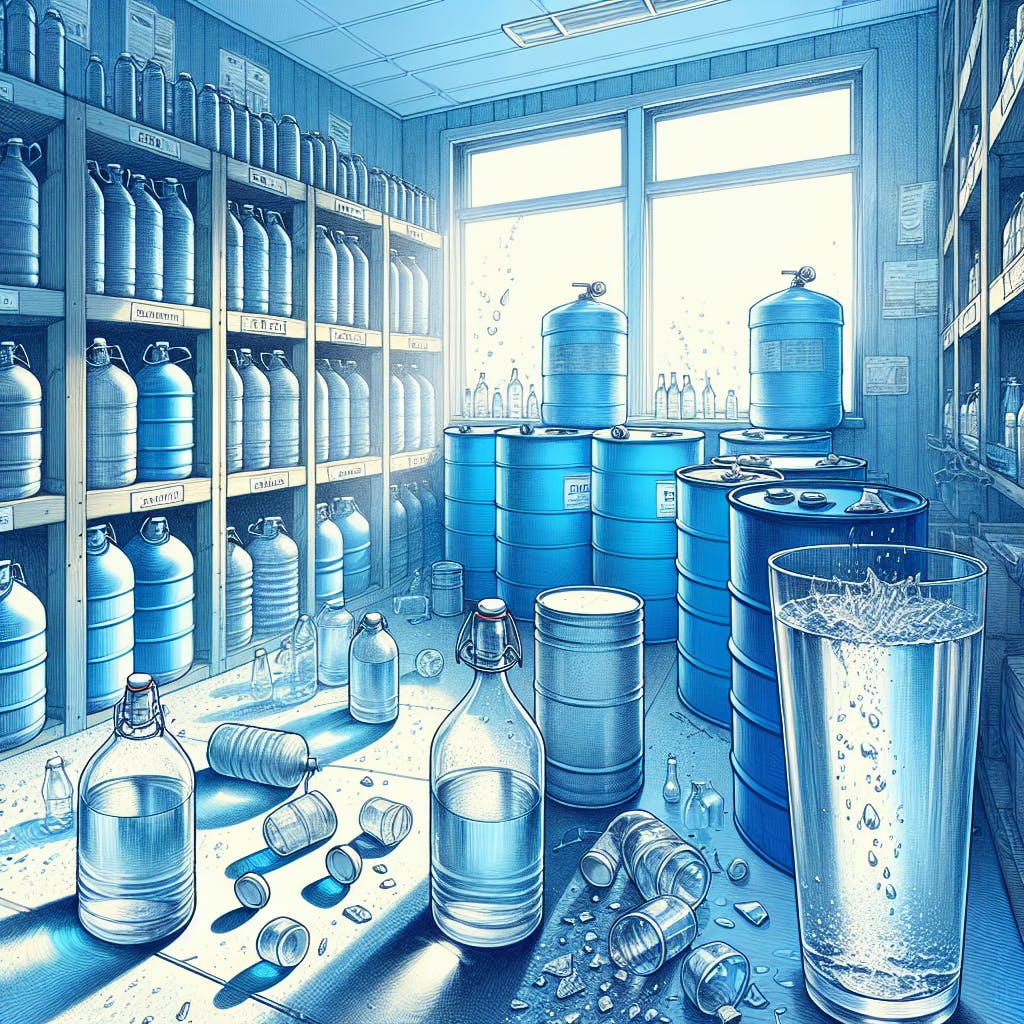When crisis strikes, having an emergency food supply is crucial for survival. Most would agree that being prepared with shelf-stable essentials provides critical nourishment when access to perishable foods is disrupted.
This guide details the top foods to stockpile for emergencies based on nutritional balance, shelf life, and ease of preparation. You'll discover the essential items for your emergency kit to keep your family nourished if disaster strikes.
We'll cover the importance of an emergency food supply, the best survival foods to store, how to maintain nutrition during a crisis, and tips for extending shelf life. You'll learn how to build a well-rounded stockpile tailored to your household's unique needs.
Essentials of an Emergency Survival Food List
Having the right foods stockpiled can make a major difference in an emergency situation. When choosing items for your survival food supply, focus on shelf-stable foods that meet key criteria:
Understanding the Importance of an Emergency Preparedness Kit
An emergency preparedness kit contains critical supplies to help you withstand a crisis scenario. Food and water are essential components. Having adequate reserves allows you to shelter in place safely for extended periods. Key benefits include:
- Avoiding risky supply runs
- Maintaining health and nutrition
- Frees up time for other priorities
- Provides comfort in stressful times
Take steps to assemble a well-rounded kit customized to your household's needs. Rotate and replenish items regularly.
Assessing Your Nutritional Needs in Crisis Situations
During emergencies, maintaining balanced nutrition can be challenging but remains important. Key considerations when planning your food stockpile include:
- Shelf life - Prioritize non-perishables with longer expiration dates.
- Caloric density - Stock nutrient-rich foods to avoid malnutrition.
- Special needs - Accommodate medical conditions, allergies, infants.
- Supplements - Store multivitamins to fill nutritional gaps.
- Variety - Alternate food types to support morale and health.
Evaluate your needs thoroughly and tailor your supplies accordingly.
The Role of Non-Perishable Food for Emergency
Non-perishable foods that don't require refrigeration are indispensable for emergency preparedness. Benefits include:
- Indefinite shelf life if stored properly
- Critical backup if power is lost
- Reduced chance of foodborne illnesses
- Lightweight and portable if evacuation needed
- Nutrient-rich options available (canned fish, beans, vegetables)
Build your survival stockpile around non-perishables suited to your situation.
Strategies to Keep Foods Fresh and Safe During a Power Outage
Losing electricity compromises food safety, making it vital to conserve freshness. Useful tips include:
- Group foods together to retain cold temperatures
- Use ice or freezer packs to chill perishables
- Cook, freeze, or preserve items at risk of spoiling
- Monitor temperatures with a food thermometer
- Discard anything that smells, tastes, or looks spoiled
Follow best practices to avoid foodborne illness when refrigeration is not possible.
Prioritizing shelf life, nutritional balance, and safe storage practices when choosing emergency food supplies helps ensure you can nourish your household comfortably through times of crisis. Reevaluate needs frequently and refresh stock as items expire.
What are the top 10 survival foods?
When building an emergency food supply, it's important to focus on nutritional balance, shelf life, and ease of preparation. Here are 10 of the best foods to stockpile:
-
Whole grains like oats, wheat berries, and rice. Properly stored, these staples can last 30 years or more. They provide complex carbs and fiber. Consider instant oatmeal or minute rice for convenience.
-
Canned goods like vegetables, fruits, beans, soups, and meats. Canned varieties can provide you with essential nutrients and are convenient to prepare. Opt for low-sodium options when possible.
-
Nuts and seeds are calorie-dense and packed with protein. Stored properly in a cool, dark place, most last 1-2 years. Almonds, walnuts, sunflower seeds, and pumpkin seeds are excellent choices.
-
Dried beans and lentils are an economical source of plant-based protein with a shelf life of up to 30 years. They are more convenient with a pressure cooker.
-
Canned or powdered milk provides calcium and vitamin D. Unopened, shelf-stable milk keeps for 6-12 months. Powdered milk lasts much longer but requires mixing with water.
-
Vegetables like potatoes, onions, garlic, carrots, and winter squash last for months when stored in a cool, dark place. Sweet potatoes and squash lend well to baking, soups, or stews.
-
Fruit options like apples, citrus, dried fruits, and canned varieties add nutrients like vitamin C. Dried fruits keep the longest. Rotate fresh fruits based on expiration dates.
-
Hard cheeses are tasty sources of protein and calcium. When properly stored and sealed, most last 6 months or longer. Consider powdered options too.
-
Cured meats like beef jerky, canned chicken, tuna, or salmon are high in protein. Canned seafood and poultry keep 2-5 years but check best-by dates.
-
Comfort foods like coffee, tea, honey, maple syrup, salt, spices, baking needs (yeast, baking powder), and condiments help round out the food supply.
What foods should you stockpile for an emergency?
When building an emergency food supply, it's important to focus on shelf-stable items that provide nutritional balance, have a long shelf life, and are easy to prepare if the power goes out. Here are some of the most essential foods to include:
Canned and Jarred Foods
Canned meats, fruits, vegetables, soups, and beans are convenient options since they don't require refrigeration. Prioritize low-sodium and canned varieties packed in water over saltier versions. Include a manual can opener in your emergency kit.
Staples
Stock up on non-perishables like peanut butter, crackers, cereals, pasta, rice, oils, and spices. Opt for whole grain versions when possible.
Dried and Dehydrated Fruits/Vegetables
Dried fruits, vegetables, and herbs retain more nutrients than fresh options. Look for unsweetened and low-sodium versions.
Nut Butters and Nuts
High in protein and healthy fats, these foods provide lasting energy. The oils may separate after long storage, so give them a good stir before eating.
Water
Having an emergency water supply is critical. Store commercially bottled water or fill clean containers with tap water. Plan for at least one gallon per person, per day. Properly stored water can last up to 5 years.
What food should I pack for emergency?
When building an emergency survival food list, it's important to include items that meet key criteria: nutritional balance, long shelf life, and ease of preparation.
Here are some recommended items to include in a basic emergency supply kit:
-
Ready-to-eat canned meats, fruits and vegetables: Canned varieties can provide you with essential nutrients and don't have to be refrigerated. Opt for low-sodium options when possible.
-
Protein or fruit bars: These shelf-stable snacks pack a nutritional punch. Look for options with 5g or more of protein.
-
Dry cereal or granola: Choose whole grain varieties and pair with non-perishable pasteurized milk.
-
Peanut butter: High in protein and healthy fats. Stays fresh for months after opening.
-
Dried fruit, nuts: Excellent sources of nutrients. Unsalted nuts last longer.
-
Crackers: Whole grain crackers provide good carbs. Check expiration dates.
-
Canned juices: Help you stay hydrated. You should drink enough water every day.
Having the right emergency food supplies can provide comfort and nutrition during a crisis. Be sure to check expiration dates and storage instructions. Properly stored items like flour, rice and canned goods can keep foods fresh and safe for extended periods.
What is the best foods to store for doomsday?
When preparing your emergency food supply, it's important to focus on nutritional balance, shelf life, and ease of preparation. Some of the best foods to stockpile include:
Peanut Butter
Peanut butter is packed with protein, nutrients, and healthy fats. It has a long shelf life and is a versatile ingredient that can be eaten by itself or used in recipes. Choose natural peanut butter without hydrogenated oils.
Whole-Wheat Crackers
Crackers made from whole grains provide fiber, protein, and important nutrients. Look for low-sodium options and pair them with peanut butter for a balanced snack. Check expiration dates and store in airtight containers once opened.
Nuts and Trail Mixes
Stock up on nuts like almonds, walnuts, and cashews as well as pre-made trail mixes. Nuts are nutritious, convenient, and full of protein and healthy fats to keep you feeling energized. Go for unsalted varieties in vacuum-sealed pouches.
Canned Tuna, Salmon, Chicken
Keep a supply of canned proteins like tuna, salmon, and chicken on hand. Canned varieties can provide you with essential nutrients and are ready to eat straight out of the can. Opt for low-sodium options packed in water.
Canned Fruits and Vegetables
Fruits and veggies stored in cans have a shelf life of at least 2 years. Stock up on canned green beans, carrots, peas, pears, peaches, and other favorites. Rinse canned veggies before eating to remove excess sodium.
Be sure to store emergency food supplies in a cool, dry place and check expiration dates every 6 months. Rotate stock by using older items first to ensure freshness. Stay hydrated by drinking at least a half gallon of water per day.
sbb-itb-b932644
Selecting the Best Foods to Stockpile for Doomsday
When building your emergency food supply, it's important to focus on shelf-stable items that provide nutritional balance, have a long shelf life, and are easy to prepare if the grid goes down.
Foods That Last a Long Time Without Refrigeration
Canned goods, dried beans, rice, pasta, oats, wheat, and nut butters are great options since they don't require refrigeration. Canned foods like meats, fruits, vegetables, and soups can last 2-5 years if stored properly. Items like honey, salt, soy sauce, vinegar, and pure maple syrup also have an indefinite shelf life. When stockpiling, be sure to check expiration dates and store items in a cool, dark place.
Importance of Canned Foods in Your Emergency Kit
Canned varieties can provide you with essential nutrients if fresh options aren't available. Focus on fruits packed in juice, vegetables low in sodium, canned meats, fish, beans, and soups. Aim for a mix of veggies, proteins, fruits, and beans/legumes to meet nutritional needs. Having 3-6 months' worth of canned goods is recommended for emergency preparedness.
Opting for Low-Sodium Options in Canned Goods
To maintain heart health during a disaster scenario, opt for low-sodium canned items when possible. While canned goods allow for long-term storage, some varieties can be high in sodium. Seek out "no-salt-added" or "low sodium" on the label. Pair with other shelf-stable items like rice, oats, pasta, and quinoa to further reduce sodium intake.
Properly Stored Flour: A Versatile Staple
As long as stored properly in airtight containers, flour can keep for up to a year at room temperature. Whole wheat and white flour both have a lengthy shelf life. Flour allows you to bake nutritious breads, muffins, tortillas, pancakes, etc if the grid goes down. To prolong freshness, consider storing flour in the refrigerator or freezer after opening. This provides a versatile ingredient for cooking during an emergency.
Ensuring a Nutritional Balance in Your Emergency Food Supply
A balanced diet is crucial for health, even in emergency situations. When stockpiling food for disasters, it's important to incorporate items from key food groups to maintain nutritional balance.
Incorporating Protein Sources for Energy and Repair
Protein helps preserve muscle mass and provides the body with energy. Good shelf-stable, non-perishable protein sources include:
- Canned beans, chickpeas, lentils
- Nuts and nut butters
- Canned tuna, salmon, chicken, turkey
- Beef or turkey jerky
- Protein or granola bars
Canned varieties provide essential nutrients like iron, zinc, and B vitamins. Seek low-sodium options when possible.
Adding Vitamins and Minerals Through Shelf-Stable Produce
Fruits and vegetables supply vital vitamins and minerals. Some non-perishable options are:
- Canned fruits and vegetables
- Dried fruits like raisins, cranberries, apricots
- 100% fruit leather or fruit chips
- Tomato sauce, pasta sauce, salsa
- Potato flakes, sweet potato flakes
Canned and dried varieties maintain nutrients without refrigeration. Prioritize less-processed options.
The Role of Grains and Carbohydrates in Energy Sustenance
Complex carbs from whole grains provide the body with a steady supply of energy. Some examples are:
- Whole wheat flour, pasta, crackers
- Brown rice, quinoa, oats
- Cereals, granola
- Popcorn
Properly stored, these items keep for extended periods. Pair with protein sources for balanced meals.
Considering Dietary Restrictions and Allergies
When stockpiling emergency food, account for any dietary restrictions, food allergies, or intolerances. Read ingredient labels closely. Some allergen-free options are:
- Gluten-free pasta, flour, crackers
- Dairy-free milk substitutes like almond milk
- Egg-free pasta, cookies, bread
- Nut-free bars, trail mixes
Having a variety of foods ensures safe, nutritious meals for all in an emergency.
Prioritizing Shelf Life and Ease of Preparation
When building an emergency food supply, it's crucial to prioritize foods with long shelf lives that are also easy to prepare. Having supplies that can last and be readily eaten during a crisis is key.
Understanding and Checking Expiration Dates
Regularly checking expiration dates on stored foods ensures they remain safe to eat and maintains freshness as long as possible. As a general rule:
- Canned goods can last 2-5 years unopened
- Once open, canned food lasts 3-4 days refrigerated
- Dry goods like rice, beans, pasta last 1-2 years unopened
Create a rotation system and check dates every 6 months. Discard anything expired.
Choosing Foods with Minimal Preparation Required
Stocking ready-to-eat foods eliminates the need for cooking appliances or extensive prep in an emergency. Great options include:
- Canned fruits, vegetables, beans
- Canned tuna, chicken, salmon
- Beef jerky
- Granola, protein bars
- Nuts, trail mixes
- Peanut butter
- Canned soups or chili
Choose pop-top cans when possible and have a manual can opener on hand.
Tips for Extending the Shelf Life of Your Stockpile
Proper storage can help your emergency food last longer:
- Store in a cool, dry place around 55-70°F
- Keep food in airtight containers or oxygen absorber packets
- Buy smaller packages to limit air exposure
- Freeze perishable items like bread, meats
- Regularly check containers for pests
Follow all guidelines for maximum freshness and safety.
Creating a Rotation System for Your Food Stockpile
To prevent waste from expiration, implement a first-in, first-out rotation system:
- Label all items with purchase dates
- Use oldest supplies first
- Set reminders to replenish every 6 months
- Donate items close to expiration to food banks
Rotating foods ensures you have a fresh, safe stockpile when you need it most. The key is staying organized and vigilant.
Creating and Storing an Emergency Water Supply
Having an adequate supply of safe drinking water is critical in an emergency situation. Here are some tips for storing enough water to meet your hydration and cooking needs if a disaster strikes.
Calculating Daily Water Needs for Survival
You should drink at least a half gallon of water per day to maintain health. To calculate your water needs:
-
Plan for at least 1 gallon per person per day. This covers drinking and basic hygiene and food preparation.
-
Store extra water if you live in a hot climate, are pregnant or ill, or doing strenuous activity.
-
Make sure to account for pets when calculating total water storage needs.
Securing Water Sources and Storage Solutions
-
Store commercially bottled water in a cool, dark place and check expiration dates.
-
Use food-grade plastic containers with tight lids to store tap water. Replace every 6 months.
-
Consider large water storage containers, barrels, or cisterns if you have space.
-
Identify alternative water sources like rainwater collection, streams, springs, or wells. Have a backup plan.
Protecting Water Quality in Emergencies
-
Add 8 drops of bleach per gallon to prevent bacteria growth in stored water.
-
Label storage containers with preparation date and replace every 6 months.
-
Store water away from gasoline, kerosene, pesticides to avoid contamination.
-
Boil water for 1 minute before use if unsure of quality. Have a water filtration system as backup.
Emergency Water Supply Maintenance
-
Take inventory and replace emergency water every 6 months, checking for leaks.
-
Rotate stored water supplies - use oldest first, replace right away.
-
Ensure water storage areas are clean, temperature controlled, and pest free.
-
Test water quality using test strips if storing long term.
Keeping an ample supply of safe, potable water is vital for survival in an emergency. Follow these tips to calculate needs, secure sources, store properly, and maintain quality.
Conclusion: Essential Considerations for Your Emergency Food Supply
When building your emergency food supply, the key considerations are nutritional balance, shelf life, and ease of preparation. Having a variety of non-perishable foods that provide essential nutrients while lasting for years in storage is crucial.
Recap of Nutritional Balance and Food Variety
It's vital that your emergency food list includes items from all the major food groups - grains, protein, fruits, vegetables, and dairy. Canned and dried varieties can provide you with essential nutrients when fresh options aren't available. Be sure to have low-sodium options as well as some comfort foods.
The Imperative of Regularly Updating Your Food Supply
Check expiration dates on your emergency food items every 6 months. Replace anything that's expired or close to expiring. Also restock items that have been used so you always have at least a 2 week supply. Keeping your food storage current ensures you'll have safe, nutritious options when needed.
Final Tips for Emergency Preparedness
In addition to food, store at least 1 gallon of water per person per day. Have a manual can opener, fuel for cooking, paper plates, etc. Know how to safely store and prepare your emergency food too. Being proactive allows you to weather any storm.


